Template:Semi-protected
Dwarves were a race in Middle-earth also known as the Khazad, the Naugrim (meaning 'Stunted People'), and Gonnhirrim (meaning 'Masters of Stone').
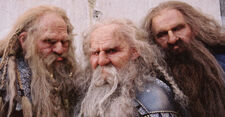
Elderly Dwarves
History
Creation
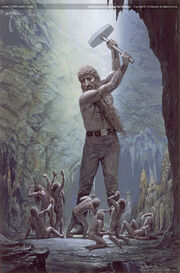
"Aulë Prepares to Destroy His Children." Illustration, by Ted Nasmith.
The Dwarves were made by Aulë, whom they themselves call Mahal, meaning “maker.” Aulë was unwilling to wait for the coming of the Children of Ilúvatar, for he was impatient and desired to have someone to teach his lore and crafts. Therefore, he made the first Seven Fathers of the Dwarves in secret in a hall under the mountains of Middle-earth.
It was, however, not within Aulë's power to create life. After being reprimanded by Ilúvatar and realizing his error, Aulë offered his creations to his father to do with as he would, including their destruction. Even as the offer was made, Ilúvatar accepted and gave the Dwarves a life of their own. So when Aulë picked up a great hammer to smite the Seven Fathers and destroy his presumptuous creations, they shrank back in fear and begged for mercy.
Ilúvatar was however not willing to suffer that the Dwarves should come before the Firstborn (Elves), and he decreed that the Seven Fathers should sleep underground and should not come forth until the Firstborn had awakened.[2]
First Age
About a century after the Elves awakened, the Seven Fathers of the Dwarves were roused. Of those seven, only the name of one is known, Durin I, who was called the deathless. Each one of the seven fathers became a king of his own clan, and each built his own great hall. Three major holds are known to have been built in the First Age. Belegost and Nogrod were built in the Blue Mountains, and the Dwarves of these holds formed alliances with the Ñoldor and fought in their wars. Durin I, on the other hand, wandered into a vale in the Misty Mountains he named Azanulbizar. In a still pool in that vale, he saw a reflection of himself with a crown of seven stars. Ever after, the constellation of stars that the Elves call Valacirca was called by the Dwarves Durin’s Crown, and it could be seen reflected in the water at any time of the day, though only Durin could see his own reflection. Durin I named the lake Kheled-zâram and proceeded to build his great hall, Khazad-dûm, in the mountains above. In the First Age, the Dwarves made alliances with the Elves, and both prospered from trade. Dwarves from Belegost invented the famous Dwarf-mail of linked rings and fashioned the finest steel the world had ever seen. They also constructed the hall of Thingol, Menegroth, and were rewarded with the pearl Nimphelos. They fought alongside Elves and Men and participated in some of the major battles of the First Age, including The First Battle of Beleriand and the Nirnaeth Arnoediad in which the Dwarves of Belegost won great renown for being the only ones able to stand against the dragon Glaurung, for 'it was their custom moreover to wear great masks in battle hideous to look upon', which 'set them good stead against dragons', and besides they were 'naturally able to resist fire better than elves or men'. In that battle, Azaghâl the Lord of Belegost was killed by Glaurung, who crawled over him. Before dying, the dwarf stabbed at the dragon's belly with his knife and 'pricked him so deep that he fled back to Angband'.
The Dwarves of Nogrod were famous for the craftsmanship of their weapons. Most notable amongst their smiths was Telchar. Dwarves from Nogrod crafted the necklace Nauglamír, and Thingol requested Dwarven smiths from Nogrod to set a Silmaril into that necklace. Thus were united the greatest works of Elves and Dwarves. Those Dwarf-smiths were driven mad by gold-lust, however, and murdered Thingol and stole the necklace and the stone, igniting the bitter rivalry between Dwarves and Elves that would rage between the two races until the end of the Third Age.
The Elves of Doriath pursued the smiths to their deaths and reclaimed Nauglamír. But two of the slayers of Thingol escaped from the pursuit and in Nogrod told how Dwarves were slain by command of the Elven-king, who thus would cheat them of their just reward. The Dwarves of Nogrod lamented the deaths of their kin and their great craftsmen and took thought of vengeance. Though the Dwarves of Belegost tried to dissuade them from their purpose, the Dwarves of Nogrod invaded Doriath. After a hard battle in the Thousand Caves, the Dwarves of Nogrod were victorious and took Nauglamír and the Silmaril. On their return journey to the Blue Mountains, however, the Dwarves of Nogrod were assailed by a company that included Beren, his son Dior, and many Green-elves of Ossiriand. Many of the Dwarves were slain, and Beren himself slew the Lord of Nogrod and wrested from him the necklace Nauglamír. Some of the Dwarves escaped from the battle, but they were ambushed in the slopes beneath Mount Dolmed by the Shepherds of the Trees.
Some stories from the first age tell of petty Dwarves who were called Noegyth Nibin. Those were Dwarves exiled from their homes during the Peace of Arda and were the first Dwarves to enter Beleriand. It was petty Dwarves who first inhabited and carved out The Caverns of Narog, which they called Nulukkizdîn, but were later taken over by Finrod and called Nargothrond. The last of this line were Mîm and his two sons who lived at Amon Rûdh and aided Túrin in his adventures.
Second Age
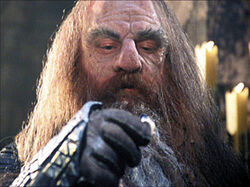
Durin III as depicted in The Lord of the Rings Trading Card Game, holding his Ring
After the First Age most tales telling of Dwarves are about the Dwarves of the line of Durin, who are commonly called Durin’s Folk or Longbeards. Durin I enjoyed a very long life and lived through most of the First Age. Every now and then through the following ages a Dwarf was born of this line that was so alike to Durin that he was considered to be Durin reborn. Prophecy told that Durin would be reborn seven times and the coming of Durin VII would mark the decline of the Dwarves.
Durin II was born in the Second Age. It is not known exactly when, but he was in power when the smith Narvi built the west gate of Khazad-dûm in the year 750. His reign was an era of great prosperity in which the halls of Khazad-dûm were greatly expanded and the Noldorin Elves of Lindon moved into Eregion to trade with the Dwarves for mithril. Population boomed because many refugees from Belegost and Nogrod, which were destroyed at the end of the First Age, moved to Khazad-dûm.
Durin III was in power around the year 1600 of the Second Age. He was gifted with the seventh and most powerful of the Dwarven Rings of Power. It was the Elven smith Celebrimbor and not Sauron who gave him the ring. The rings of power did not have the effects that Sauron had intended, possibly because Aulë had made the Dwarves especially resistant to evil domination. The only apparent effect of the Dwarven rings was that the Dwarves became more greedy with gold lust, but they were not turned into wraiths like men. Sauron tried to recover the rings. Two he reclaimed fairly soon and four ended up in dragon hoards. Sauron did not reclaim the ring of Durin until the 2845th year of the Third Age when he captured Thráin II.
50,000 of Durin's folk helped in the battles of the Last Alliance.
Third Age
Durin VI was born in the 1731st year of the Third Age. At that time the race of Dwarves had already begun to dwindle.
Awakening of the Balrog
In the year 1980 of the Third Age the Dwarves were deepening their mithril mines when they stumbled upon a Balrog of Morgoth. Durin VI was slain by the Balrog, and a year later so was his son Nain I (TA 1832 - TA 1981). After that the Dwarves of Durin's line fled and abandoned Khazad-dûm — but the Balrog, now known as Durin's bane, remained.
Relocation from Khazad-dum
Most of Durin’s Folk went to the Grey Mountains where they built new halls. However Nain's son Thrain I (TA 1934 - TA 2190), now King of Durin’s Folk, went to the Lonely Mountain and founded the kingdom of the Lonely Mountain in the year TA 1999. Deep within the mountain he found an extraordinary jewel that he called the Arkenstone and regarded it as the greatest treasure of his house.
Thrain's son Thorin I chose to stay in the Grey Mountains rather than in the Lonely Mountain, so between TA 2190 and TA 2590 the Grey Mountains were the seat of Kings. In TA 2589, however, the Dwarven halls in that region were attacked by cold-drakes from the north. The King at the time, Dain I (TA 2440 - TA 2589), was slain along with one of his sons, Frór (TA 2552 - TA 2589). His older son Thrór (TA 2542 - TA 2790) fled with his people to the Lonely Mountain.
Sack of the Lonely Mountain
Prelude

Smaug enters the city of Erebor.
For 200 years the wealth and fame of Lonely Mountain grew, until the coming of the fire-drake. Small dragon attacks were prevalent as the dragons continued to notice the Dwarves' increasing stores of gold, jewels, precious metals, and other minerals, as well as crafted treasures and artifacts.
The Attack on the Lonely Mountain
Eventually, the inevitable came; Smaug the Terrible came to the Lonely Mountain in TA 2770. The dragon attacked the nearby town of Dale, knocking down towers and breathing fire down upon the buildings, but causing little damage and death, for his main target was the treasury of the Lonely Mountain. He went down to the ground towards the Lonely Mountain and broke through the main door, and proceeded straight through the legion of Dwarven soldiers who were behind the door. The massive fire-drake completely disregarded the Dwarven soldiers' attacks and firepower and simply shrugged off anything they threw at him. The dragon went straight towards the treasury, ignoring the rest of the city and it's people. The Dwarves began to evacuate from the city in a vain attempt to get out of their city and to save what they could. The city of the Lonely Mountain was lost.
Thrór managed to escape through a back door with his family with most of the Dwarves of the Lonely Mountain evacuated, and the city and wealth of Durin's Folk lost.
War of the Dwarves and Orcs
A dwarven unit on the march in BFME2
Some time later Thrór gave his son Thráin II (TA 2644 - TA 2858) the Ring of Power and started wandering the world with his friend Nar. He ended up in Khazad-dûm where he was murdered and mutilated by the Orc king Azog. This was the catalyst of a war that was called the War of Dwarves and Orcs. The war lasted seven years and ended in the Battle of Azanulbizar, in which Dáin Ironfoot (TA 2767 - TA 3019) slew Azog. In the years to come the Ring of Power slowly poisoned Thráin's heart with greed, and in 2845 he (Thráin II) set out alone to reclaim the Lonely Mountain. This resulted in his being captured by Sauron, and he died in the dungeons of Dol Guldur.
The Quest of Erebor
In 2941 Thorin Oakenshield, son of Thráin II, along with a company of 12 other Dwarves and the hobbit Bilbo Baggins, reclaimed the Lonely Mountain (with the help of three or four armies), but at the cost of Thorin’s life. Dain Ironfoot took up rule in the Lonely Mountain after that, and for a while the kingdom prospered in trade with the Elves of Mirkwood and Men of Dale.
Balin's Expedition to reclaim Khazad-dum
In TA 2989, one of Thorin’s companions, Balin (2763-2994), took a host of Dwarves from the Lonely Mountain in an attempt to reclaim Khazad-dûm. For five years they fought the Balrog and an army of Orcs. Balin was killed by an Orc arrow in 2994 and the remainder of his host was cut off when the Orcs captured the Bridge of Khazad-dûm and the east gate. Not so much as one Dwarf lived to tell the tale.
War of the Ring
Gimli son of Gloin won considerable renown for the role he played in the War of the Ring. After the war he founded a new Dwarf Kingdom named Glittering Caves in the caves behind Helms Deep. Near the end of his life Gimli is said to have sailed with his Elven friend Legolas to the undying lands of Valinor which, if true, would have likely made him the only Dwarf to ever have made that journey.
After the Battle of the Pelennor Fields, a force of 30,000 Longbeards and 20,000 Men of Dale held the Lonely Mountain in a similar siege against 200,000 Men of Rhun who had taken all of Brand's lands, leaving only his capital city of Dale. The Dwarves and Men of Dale stood for three days against the Easterlings, and once the news of Sauron's death spread to the Lonely Mountain the Easterlings retreated, having lost over 100,000 troops, as opposed to the defenders who lost 14,000 Dwarves and 12,000 Men. The sturdy nature of the Mountain Rock, combined with the Dwarven masonry and the Dwarven quality of the defenders' weapons, reduced the hitting power of the Easterlings' two-armed catapults and semi-automatic ballistas, and allowed the defenders to drive the attackers from the Mountain and out of Brand's realm.
After the Third Age
During the Fourth Age, which began after the destruction of Mordor and Sauron, Dwarves and Men re-forged their friendship. Dáin was killed during the War of the Ring, and was succeeded by his son Thorin III Stonehelm who ruled well into the Fourth Age. During this time, Dwarves from the Lonely Mountain helped rebuild cities in Gondor and the fortress of Helm's Deep, and some went to the newly established Dwarven realm of the Glittering Caves where Gimli was lord. Nevertheless, the Kingdom of the Lonely Mountain apparently continued to prosper throughout the Fourth Age.[3][4]
Fourth Age
Not much is known about the Dwarves in the Fourth Age. After the War of the Ring, Gimli brought a part of Durin's Folk from the Lonely Mountain to the Glittering Caves behind Helm's Deep and founded a colony there. Subsequently, Gimli went on many travels with his friend Legolas, and History lost track of their fate. Through their friendship and influence, the feud between the two races that had lasted for millennia finally ended, shortly before the departure of the last Elves from Middle-earth. It is rumored that Gimli and Legolas eventually boarded a ship that sailed down the river Anduin, out to sea and across to Valinor in the year FO 120 Gimli would thus have become the only Dwarf to ever be permitted to cross to the Undying Lands.
Durin VII (the Last), retook Moria and brought Khazad-dûm back to its original splendor, and the Longbeards lived there till the "world grew old and the days of Durin's race ended."
Culture
Appearance
- "It was a dwarf with a blue beard tucked into a golden belt, very bright eyes under his dark-green hood."
- —The Hobbit, Chapter 1: "An Unexpected Party"
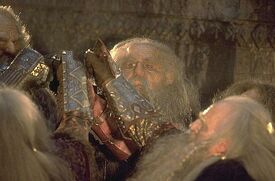
Dwarf-lords, raising their rings
When Aulë created the Dwarves he had only a vague idea of what the Children of Ilúvatar should look like. Because of the threat of Morgoth over the world, Aulë made them very strong, both in body and character.
Dwarves were a short, stocky race, a little taller than hobbits but much broader and heavier. Most Dwarves had thick, luxuriant beards in which they took great pride, and often forked or braided them and tucked them into their belts.
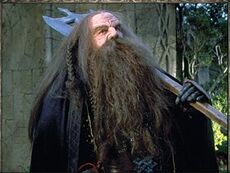
A typical Dwarf
They seem to have favoured simple durable clothing, coloured hoods and heavy cloaks for travelling, and belts of gold or silver. For battle their soldiers would have elaborately crafted armor and helmets, bearing various angles and styles that were trademarks of Dwarven crafting styles. Their armor was masked with symbols (after the manner of those used in forges for shielding the eyes) that were hideous to look upon.
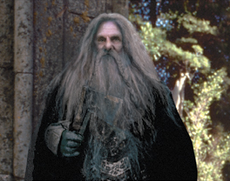
An elder Dwarf
Dwarven women were alike in manner, voice and appearance to their menfolk. They were few in number, less than a third of all dwarf-kind, and they were seldom seen outside their own halls, often not venturing far due to their duties as caretakers and crafters in Dwarven society. They typically only travelled when in great need, and they usually dressed similarly to Dwarf men. This often led other folk to believe there were no women among the Dwarves, that Dwarves grew from stone when created. Few female Dwarven warriors were known, but some tales say that female Dwarves were as fierce as their male counterparts, especially in protecting their families and offspring. Dwarves were usually monogamous, and fewer than one-third of Dwarven men took a wife, the rest busying themselves with their crafts.
Physiology
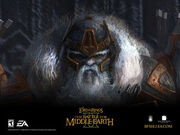
King Dain II
Dwarves were a proud and stern race and were made to be sturdy to resist the dangers of their time. They were physically very strong, had great endurance, especially in the ability to resist heat and cold, and they made light of heavy burdens. Dwarves lived longer than Men,[2] often up to two hundred and fifty years. The Dwarven lords of the First and Second Age may have lived for several hundred years. Dwarves had the ability to learn new artisanal skills quickly, especially those dealing with metal or stone.
Dwarves were typically stubborn, secretive, and fiercely loyal to their friends. They cared greatly about mining, crafting, crafts, gold and gems, their acquisition of which often fueled the envy of the Elves. Dwarves were easily offended by rude comments, and had a propensity to hold long-lasting grudges. Dwarves were often seen as greedy, but their nature gave them resistance to many external influences, including to the evil of the Rings of Power given them. Whereas the Men who owned the nine Rings were corrupted and became the Nazgûl, the Dwarves were unaffected, save by an increase of their goldlust and hatred for anything that stood between them and what they perceived as their treasure.
Crafting
Dwarves were taught special skills by the Vala Aulë and spent most of their time crafting, smithing and mining in their massive underground cities.
The Dwarves were some of the greatest miners ever to exist in Middle-earth. The Dwarves dug immense halls under mountains where they built their cities. Dwarven miners dug for precious minerals such as gold, iron, copper, and silver from all over mountains in Middle-earth, though the Dwarves considered coal mining degrading. In ancient times, the Dwarves found Mithril in the mines of Khazad-dûm. While mining beneath the Lonely Mountains, they discovered the Arkenstone at the Heart of the Mountain.
They were also capable masons and smiths - Dwarven smithing skills were said to be rivaled only by those of the Elves, and their masonry creations were bested by none. The skill of the Dwarves was unmatched; they crafted objects of great beauty out of diamond, emerald, ruby and sapphire. Everything Dwarven was beautifully crafted and intricate. They crafted many famed weapons, armors, and items of art and beauty, among them Narsil, the sword of Elendil, the Dragon-helm of Dor-lómin and the necklace Nauglamír.
Dwarven armies were vast and powerful, and possessed vast legions of soldiers, cavalry and siege weapons, and their soldiers were equipped with powerful weapons, armors and tools for battle. Many different weapons were utilized by their soldiers, such as swords, axes, throwing axes, throwing knives, and warhammers.
They had a knack for starting a fire almost anywhere out of almost anything. Although they knew how, Dwarves did not farm or herd often, as they preferred to spend their time underground mining and crafting. They rather traded crafted items with men and elves in exchange for food.
Architecture

The deep halls of the Lonely Mountain.
They built many famed halls including the Lonely Mountain, Belegost, Nogrod, Khazad-dum, and Menegroth. The Dwarves also reforged the gates of Minas Tirith and rebuilt the walls of Helm's Deep after the War of the Ring.
Their cities appeared to be constructed just under mountains or mountain ranges. Dwarven miners would excavate into the mountains to create an entrance, and then dig through and under the mountain to create the groundwork for their cities. Dwarven cities were absolutely massive and very expansive, reaching the far depths of the earth. Dwarves continued to mine in their cities to expand them and discover more resources like precious metals and minerals.
Dwarven cities ran throughout mountains and mountain ranges, stretched up, down and side-to-side in the massive caverns beneath the surface, but it was largely unknown how cities were structured and sectioned off. In Khazad-dum, there was a section of the city known as the Chamber of Mazarbul, also known as the Chamber of Records. There were also sections of the city mentioned in the Book of Mazarbul such as the "First Hall," "Second Hall," "Third Deep," "Twenty-first hall" and the "North end."[5]
The beauty of the Dwarves' cities was legend. One stronghold, Erebor (located in the Lonely Mountains), had its wealth coming from precious gems hewn from rock and in "great seams of gold running like rivers through stone."
A name for where the Dwarves' were located was Phurunargian, which meant Dwarf-delving in the Common Tongue.[6]
Notable Dwarven Realms
- Khazad-dum, under the Misty Mountains
- Nogrod and Belegost, under the Blue Mountains
- Lonely Mountain/Erebor
- Grey Mountains
- Iron Hills
- Glittering Caves
- Orocarni (Red Mountains)
Language and Writing System
- "Baruk Khazâd! Khazâd ai-mênu!"
- —Ancient dwarven battle cry meaning "The axes of the dwarves! The dwarves are upon you!"
Language
The Dwarven language was created by Aulë when he created the Dwarves themselves, and called it Khuzdul, which meant 'Dwarvish'. The language was a harsh sounding tongue and sounded strange and harsh to other races, and no other non-dwarf did they permit to learn their language[1] for it was guarded jealously. They rarely spoke their own language around other races, and preferred to use the languages of other races when around them.
Writing System
The Dwarves used Angerthas, a runic writing system based on Cirth. There were different variations of Angerthas, which varied by each Dwarven clan; the Dwarves of Khazad-dum had their own variation and introduced a number of unsystematic changes in the system. The Dwarves of Erebor also used a further modification of the system, which was known as the mode of Erebor. The mode of Erebor was notably exemplified in the Book of Mazarbul.[7]
Some examples of Angerthas were seen in notable Dwarven texts, including the Book of Mazarbul, Thror's Map, as well as other objects such as the Key to the Side-door, the key which unlocked the side door of Erebor.
Weapons and Armour
- "Each one of his folk was clad in a hauberk of steel mail that hung to his knees, and his legs were covered with hose of a fine and flexible metal mesh.... In battle they wielded heavy two-handed mattocks; but each of them had also a short broad sword at his side and a round shield slung at his back. Their beards were forked and plaited and thrust into their belts. Their caps were of iron and they were shod with iron, and their faces were grim."
- —The Hobbit, "The Clouds Burst
See Dwarven Weapons and Armour
Dwarven soldiers usually used axes as their weapon of choice because it can be used as a tool or a weapon, but in addition to axes they used hatchets, mattocks, short swords, war hammers, and very occasionaly there is mention of Dwarven archers.
As for armor, Dwarves favored chain-mail and other metallic armor — the most expensive and precious of which was ring mail made of mithril. (A vest of mithril was given to Bilbo by Thorin before The Battle of the Five Armies. It was worn during the battle and later protected his nephew Frodo throughout his quest.) Gandalf said that this small coat was worth more than the whole of the Shire combined.[8]
Music
Many songs were sung in the deep and grand halls of the Dwarves. One very notable song of the Dwarves was "Far over the Misty Mountains Cold", also known as the "Song of the Lonely Mountain," and commonly referred by fans as the "Dwarf Song."[9] Another song sung in Dwarven culture was the Song of Durin. This song told of the history of Khazad-dum/Moria and honored Durin, first leader of Durin's Folk.[8]
Wicked Dwarves
Of the races, Dwarves are the most resistant to corruption and influence of Morgoth and later Sauron. The seven rings of Power of the dwarves did not turn them to evil, but it did amplify their greed and lust for gold. It is said that very few willfully served the side of darkness. The Hobbit refers to these as wicked dwarves.[10] Of the seven houses few fought on either side during The Last Alliance at the end of the Second Age, and none from the House of Durin ever fought on the side of evil.[11] However, in times of war, Dwarves often refused to ally themselves with Elves or Men, choosing to remain neutral or oblivious to the clashes between good and evil. During the early parts of the Third Age, it is known that in some places wicked dwarves had made alliances with the goblins and orcs.[12] It is suggested by Tolkien in some of his notes that the dwarves that turned to wickedness most likely came from the far eastern mansions (and perhaps some of the nearer ones), and came under the Shadow of Morgoth and finally turned to evil. It is however unclear if these refer to Dwarves beyond Iron Hills (the most eastern known stronghold of the Dwarves)[13] Because Dwarves are not evil by nature, few ever served the Enemy of their own free will (though rumors of Men suggest the total was greater).[6]
In some of Tolkien's earliest writings the Dwarven race as a whole was portrayed as an evil creation of Melkor, but Tolkien's ideas evolved as he continued to write about the Dwarves.
The Seven Clans
The Dwarves' seven clans were:
- 1. Longbeards, also known as Durin's Folk; originally from Mount Gundabad they also founded the great Dwarf Mansion of Khazad-dûm (a.k.a. Moria or Dwarrowdelf) in the Misty Mountains, the Iron Hills, the holds in the Grey Mountains and, finally, the Lonely Mountain.
- 2-3. Firebeards & Broadbeams. Originally from the Blue Mountains, they were paired but Tolkien never cleared which tribe built Nogrod and which Belegost.
- 4-5. Ironfists & Stiffbeards. Originated somewhere far in the East.
- 6-7. Blacklocks & Stonefoots. Originated somewhere (else) far in the East.
- The Seven Clans of the Dwarves descended from the Seven Dwarf Fathers created by Aulë
Line of Kings of Durin's Folk
|
|
|
|
|
|
|
|
|
|
|
|
| Durin I | |||||||||||||||||||||||||||||||||||||||||||||||||||||||||
|
|
|
|
|
|
|
|
|
|
|
|
|
|
| ||||||||||||||||||||||||||||||||||||||||||||||||||||||||
|
|
|
|
|
|
|
|
|
|
|
|
| Durin II | |||||||||||||||||||||||||||||||||||||||||||||||||||||||||
|
|
|
|
|
|
|
|
|
|
|
|
|
|
| ||||||||||||||||||||||||||||||||||||||||||||||||||||||||
|
|
|
|
|
|
|
|
|
|
|
|
| Durin III | |||||||||||||||||||||||||||||||||||||||||||||||||||||||||
|
|
|
|
|
|
|
|
|
|
|
|
|
|
| ||||||||||||||||||||||||||||||||||||||||||||||||||||||||
|
|
|
|
|
|
|
|
|
|
|
|
| Durin IV | |||||||||||||||||||||||||||||||||||||||||||||||||||||||||
|
|
|
|
|
|
|
|
|
|
|
|
|
|
| ||||||||||||||||||||||||||||||||||||||||||||||||||||||||
|
|
|
|
|
|
|
|
|
|
|
|
| Durin V | |||||||||||||||||||||||||||||||||||||||||||||||||||||||||
|
|
|
|
|
|
|
|
|
|
|
|
|
|
| ||||||||||||||||||||||||||||||||||||||||||||||||||||||||
|
|
|
|
|
|
|
|
|
|
|
|
| Durin VI | |||||||||||||||||||||||||||||||||||||||||||||||||||||||||
|
|
|
|
|
|
|
|
|
|
|
|
|
|
| ||||||||||||||||||||||||||||||||||||||||||||||||||||||||
|
|
|
|
|
|
|
|
|
|
|
|
| Náin I | |||||||||||||||||||||||||||||||||||||||||||||||||||||||||
|
|
|
|
|
|
|
|
|
|
|
|
|
|
| ||||||||||||||||||||||||||||||||||||||||||||||||||||||||
|
|
|
|
|
|
|
|
|
|
|
|
| Thráin I | |||||||||||||||||||||||||||||||||||||||||||||||||||||||||
|
|
|
|
|
|
|
|
|
|
|
|
|
|
| ||||||||||||||||||||||||||||||||||||||||||||||||||||||||
|
|
|
|
|
|
|
|
|
|
|
|
| Thorin I | |||||||||||||||||||||||||||||||||||||||||||||||||||||||||
|
|
|
|
|
|
|
|
|
|
|
|
|
|
| ||||||||||||||||||||||||||||||||||||||||||||||||||||||||
|
|
|
|
|
|
|
|
|
|
|
|
| Glóin | |||||||||||||||||||||||||||||||||||||||||||||||||||||||||
|
|
|
|
|
|
|
|
|
|
|
|
|
|
| ||||||||||||||||||||||||||||||||||||||||||||||||||||||||
|
|
|
|
|
|
|
|
|
|
|
|
| Óin | |||||||||||||||||||||||||||||||||||||||||||||||||||||||||
|
|
|
|
|
|
|
|
|
|
|
|
|
|
| |||||||||||||||||||||||||||||||||||||||||||||||||||||||||||||||||||||||||||||||||||||||||||||||||||||||||||||||||||||||||||||||||||
|
|
|
|
|
|
|
|
|
|
|
|
| Náin II | ||||||||||||||||||||||||||||||||||||||||||||||||||||||||||||||||||||||||||||||||||||||||||||||||||||||||||||||||||||||||||||||||||||
|
|
|
|
|
|
|
|
|
|
|
|
|
|
|
|
|
|
|
|
|
|
| |||||||||||||||||||||||||||||||||||||||||||||||||||||||||||||||||||||||||||||||||||||||||||||||||||||||||||||||||||||||||||
|
|
|
|
|
|
|
|
|
|
|
|
| Dáin I |
|
|
|
|
|
| Borin | |||||||||||||||||||||||||||||||||||||||||||||||||||||||||||||||||||||||||||||||||||||||||||||||||||||||||||||||||||||||||||||
|
|
|
|
|
|
|
|
|
|
|
|
|
|
|
|
|
|
|
|
|
|
| |||||||||||||||||||||||||||||||||||||||||||||||||||||||||||||||||||||||||||||||||||||||||||||||||||||||||||||||||||||||||||
|
|
|
|
| Thrór |
| Frór |
| Grór |
|
|
|
|
|
| Farin | |||||||||||||||||||||||||||||||||||||||||||||||||||||||||||||||||||||||||||||||||||||||||||||||||||||||||||||||||||||||||||||||||
|
|
|
|
|
|
|
|
|
|
|
|
|
|
|
|
|
|
|
|
|
|
|
|
|
|
| |||||||||||||||||||||||||||||||||||||||||||||||||||||||||||||||||||||||||||||||||||||||||||||||||||||||||||||||||||||||
|
|
|
|
| Thráin II |
|
|
|
|
| Náin |
|
|
| Fundin |
|
|
|
| Gróin | |||||||||||||||||||||||||||||||||||||||||||||||||||||||||||||||||||||||||||||||||||||||||||||||||||||||||||||||||||||||||||||
|
|
|
|
|
|
|
|
|
|
|
|
|
|
|
|
|
|
|
|
|
|
|
|
|
|
|
|
|
| ||||||||||||||||||||||||||||||||||||||||||||||||||||||||||||||||||||||||||||||||||||||||||||||||||||||||||||||||||||
| Thorin II |
| Frerin |
| Dís |
| Dáin II |
| Balin |
| Dwalin |
| Óin |
| Glóin | ||||||||||||||||||||||||||||||||||||||||||||||||||||||||||||||||||||||||||||||||||||||||||||||||||||||||||||||||||||||||||||||||||
|
|
|
|
|
|
|
|
|
|
|
|
|
|
|
|
|
|
|
|
|
|
|
|
|
|
|
|
|
| ||||||||||||||||||||||||||||||||||||||||||||||||||||||||||||||||||||||||||||||||||||||||||||||||||||||||||||||||||||
|
|
|
| Fíli |
|
| Kíli |
| Thorin III |
|
|
|
|
|
|
|
|
|
|
| Gimli | ||||||||||||||||||||||||||||||||||||||||||||||||||||||||||||||||||||||||||||||||||||||||||||||||||||||||||||||||||||||||||||
|
|
|
|
|
|
|
|
|
|
|
|
|
|
| |||||||||||||||||||||||||||||||||||||||||||||||||||||||||||||||||||||||||||||||||||||||||||||||||||||||||||||||||||||||||||||||||||
|
|
|
|
|
|
|
|
|
|
|
|
|
|
| |||||||||||||||||||||||||||||||||||||||||||||||||||||||||||||||||||||||||||||||||||||||||||||||||||||||||||||||||||||||||||||||||||
|
|
|
|
|
|
|
|
|
|
|
|
| Durin VII | ||||||||||||||||||||||||||||||||||||||||||||||||||||||||||||||||||||||||||||||||||||||||||||||||||||||||||||||||||||||||||||||||||||
Location
The Dwarves lived and mined in several places throughout Middle-earth many times, which included:
- Moria or Khazad-dûm and other places in the Misty Mountains.
- Lonely Mountain or Erebor.
- Mount Gundabad.
- The Iron Hills.
- The Blue Mountains or Ered Luin, where the cities Nogrod and Belegost existed during the First Age.
- The Grey Mountains or Ered Mithrin, although the dwarves were later driven out by dragons.
- They possibly lived in the Orocarni, the Red Mountains of the East.
Names
The Dwarves called themselves the Khazad, the name Aulë gave them; this translates as the Hadhodrim in Sindarin, and the Casari in Quenya. Casari was the common word for Dwarves among the Ñoldor, but the Sindar usually called them the Naugrim or Nogothrim, the Stunted People.
Dwarves would, as a rule, not tell people of other races their real names, but take names in Westron instead, and keep their real names secret, not even on their tombs would they inscribe it.
Many Dwarven names in the works of Tolkien are taken from the poetic Viking prophecies, Völuspá (Old Norse: Vǫluspá). A significant part of the prophecy describes the pagan world view of the Vikings, and in that part can be found the Count of Dwarves, which is mostly a list of names. All the dwarf names from the Hobbit are taken from that source as well as the name of Gandalf. Some other names, such as Gimli (meaning shelter from fire), and Harlan are taken from the Icelandic language, but not from Völuspá. Only a few Dwarves in the works of Tolkien have original names in Khuzdul. These include Azaghâl, and Telchar.[6]
In the earlier forms of Tolkien's Mythology, the Dwarves were also called the 'Nauglath'.[14]
Earlier Forms of the Legendarium
In the earliest forms of Tolkien's Middle-earth mythology, the Dwarves were mistaken to be evil beings created by Melkor.[14]
Translations around the World
| Foreign Language | Translated name |
|---|---|
| Afrikaans | Dwerge |
| Arabic | الأقزام |
| Armenian | գաճաճ ? |
| Azerbaijani | Cırtdan |
| Basque | Nanoen |
| Bulgarian Cyrillic | Джуджета |
| Catalan | Nans |
| Chinese (Simplified) | 小矮人 |
| Chinese (Hong Kong) | 矮人 |
| Croatian | Patuljci |
| Czech | Trpaslíci |
| Danish | Dværge |
| Dari | ضواروهس |
| Dutch | Dwergen |
| Esperanto | Enanos |
| Estonian | Kääbused |
| Filipino | Unano |
| Finnish | Kääpiöt |
| French | Nain |
| German | Zwerge |
| Greeks | Νάνοι |
| Gujarati | ડ્વર્વેસ |
| Haitian Creole | Nains |
| Hebrew | גמדים |
| Hindi | बौने |
| Hungarian | Törpék |
| Icelandic | Dvergarnir |
| Italian | Nani |
| Japanese | ドワーフ |
| Kannada | ದ್ವಾರ್ವ್ಸ್ |
| Kazakh Cyrillic | Дуарвес |
| Korean | 드워프 |
| Kurdish | دوارڤهس (Arabic script) Hacûckan (Latin) |
| Kyrgyz Cyrillic | карлик |
| Latin | Nani |
| Latvian | Rūķi |
| Lithuanian | Nykštukai |
| Luxembourgish | Zwergstär ? |
| Macedonian Cyrillic | Дwарвес |
| Marathi | ड्वर्वेस |
| Maltese | Nanu ? |
| Mongolian Cyrillic | одой |
| Nepalese | ड्वर्वेस |
| Norwegian | Dverg |
| Occitan | Nan ? |
| Persian | دورف |
| Polish | Krasnoludowie |
| Portuguese | Anões |
| Romanian | Pitici/Gnomi |
| Russian | Гномы |
| Scottish Gaelic | Troichean |
| Serbian | Патуљци (Cyrillic) Patuljci (Latin) |
| Sinhalese | ඩ්෴අර්වෙස් |
| Slovak | Trpaslíci |
| Slovenian | Škrati |
| Spanish | Enanos |
| Swedish | Dvärgar |
| Tamil | குள்ளர்கள் |
| Telugu | ద్వార్వ్స్ |
| Thai | คนแคระ |
| Turkish | Cüceler |
| Ukrainian Cyrillic | Гноми |
| Urdu | بونوں |
| Uzbek | Дwарвес (Cyrillic) Mitti (Latin) |
| Vietnamese | Người lùn |
| Welsh | Chorrach |
| Yiddish | דוואָרווז |
|
Races of Arda
Ainur | Dwarves | Elves | Ents | Great Eagles | Hobbits | Huorns | Men | Petty-dwarves | Skin-changers (Beornings) Servants of the Shadow:
Barrow-wights | Ettens | Dragons (Fire-drakes and Cold-drakes) | Ogres | Orcs | Spiders | Trolls | Úmaiar | Úvanimor | Vampires | Wargs | Werewolves |
References
- ↑ 1.0 1.1 The Complete Guide to Middle-earth
- ↑ 2.0 2.1 2.2 The Silmarillion, Quenta Silmarillion, Chapter II: "Of Aulë and Yavanna"
- ↑ The Lord of the Rings, Appendix A, "Durin's Folk"
- ↑ Unfinished Tales, Part Three: The Third Age, "The Quest of Erebor"
- ↑ The Lord of the Rings, The Fellowship of the Ring, Book Two, Chapter V: "The Bridge of Khazad-dûm"
- ↑ 6.0 6.1 6.2 The Lord of the Rings, Appendix F
- ↑ The Lord of the Rings, Appendix E: Writing and Spelling, II: Writing
- ↑ 8.0 8.1 The Lord of the Rings, The Fellowship of the Ring, Book Two, Chapter IV: "A Journey in the Dark"
- ↑ The Hobbit, Chapter I: "An Unexpected Party"
- ↑ Did Dwarves Ever Serve Sauron?
- ↑ The Silmarillion, Of the Rings of Power and the Third Age
- ↑ The Hobbit, Chapter IV: "Over Hill and Under Hill"
- ↑ The History of Middle-earth, Vol. XII, The Peoples of Middle-earth.
- ↑ 14.0 14.1 The History of Middle-earth, Vol. 1: The Book of Lost Tales Part One, X: "Gilfanon's Tale: The Travail of the Noldoli and the Coming of Mankind"
